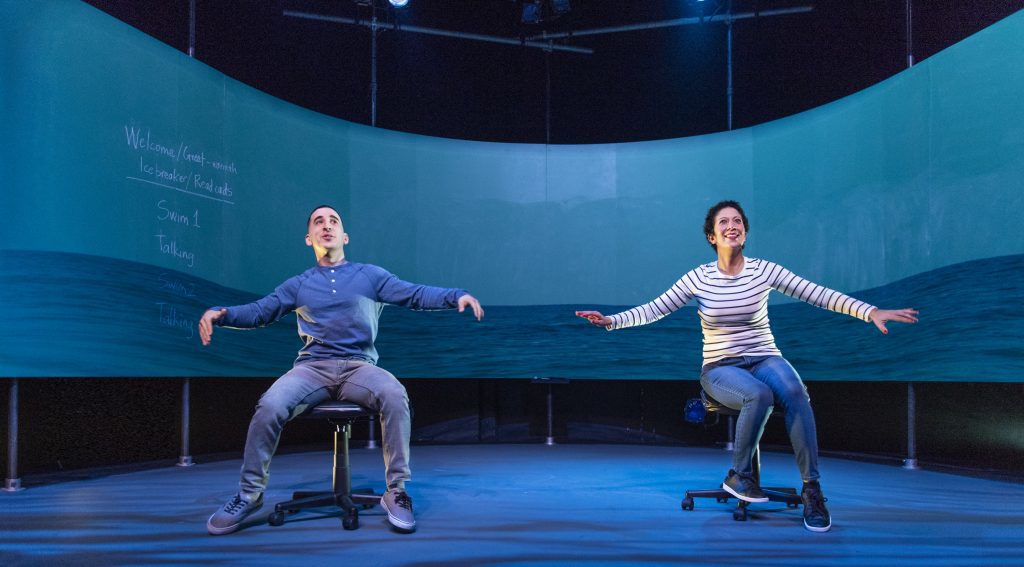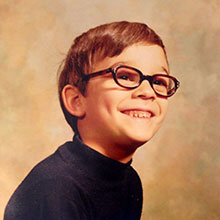
Mona Mansour’s emotional colloquium of a play, “We Swim, We Talk, We Go To War” draws much of its appeal from the warm relationship between its two main characters. Their conversations make up the majority of the action, which mainly takes place in an arena for academic argument—a graphic band of green chalkboard arcs behind the playing area—and in the far more ambiguous realm of the sea.
That these two characters are a woman in her early forties, identified only as She (Sara Nina Hayon), and her nephew, He (Joshua Chessin-Yudin) is itself a pleasant surprise. Tall, lanky Hayon strikes a delicate balance between no-nonsense elder and highly sensitive peer, while beaky, crooked-smiled Chessin-Yudin effectively conveys a youthful layering of swagger over anxiety.
It’s so rare to see detailed representations of this particular familial bond—only the far less serious “Auntie Mame” comes quickly to mind—that this world premiere, by Golden Thread Productions at the Potrero Stage, feels refreshing from the get-go. (Immediately after it ended, I began to search for the aunt-equivalent of the word “avuncular”. It’s “matertal”. You’re welcome.)
She and He clearly enjoy each other’s company, both as friends and family. During her occasional visits to San Diego, where he lives with his mother (her sister), they take pleasure in intellectual arguments, but are cautious about hurting each others’ feelings.
She identifies as Lebanese-American; he as an ROTC student, then later a commissioned U.S. officer preparing for deployment to the Middle East. While not aware of any extended family in Lebanon, She is unsettled by the notion that he may have to “kill people we are related to”. He is a generation and a father’s genes further from their Arab heritage than she is, and—with slight trepidation—feels proud and prepared to take on whatever American mission he is asked to pursue.
The duo’s tenderly contentious discussions of politics and philosophy take place during long, dog-paddling ocean swims. The saltwater provides a literal buffer zone between them along with a raft of idiomatic functions: They tread water in trying to advance their individual arguments, they don’t want to drift apart from each other, they struggle with seemingly bottomless controversy, they are at sea. “The Pacific” is ironic. When a fog settles in, obscuring the beach, their uncertainly is articulated as “Shore no more!” Mansour, too much!
While the playwright’s conceptual elbow is oversharpened in these scenes, director Evren Odcikin and an impressive design team (Kate Boyd, scenery; lighting Cassie Barnes, lighting; Mona Kasra, projection; Sara Huddleston, sound) soften its impact with a truly poetic visual approach. Ever so subtly, the flat green of the chalkboard takes on depth and fluidity beneath a palimpsest of projected waves and the ambient sound of tides. Hayon and Chessin-Yudin glide about on backless rolling chairs in these aqueous passages, feet never touching the stage. The inventive effect, coached by movement specialist Slater Penney, is lovely for the most part, but distractingly crotch-forward when the characters backfloat.
There are two other actors in the play: Tre’Vonne Bell as The American and Adam El-Sharkawi as The Arab. Both have commanding stage presence, but their brief roles are not so much flesh-and-blood characters as tools that She uses in support of her arguments. And while She and He both make many references to American military action in Iraq and Syria and Afghanistan during their conversations, they don’t really tackle political specificities. Despite being partly set in a seminar room, the play’s strength is not in the realm of intellectual education.
In the end, “We Swim, We Talk, We Go To War” is most successful in elegantly demonstrating that a balance between gently swimming around issues and talking more bluntly about them can keep otherwise loving family members from going to war with each other.
A slightly different version was published in the Bay Area Reporter
